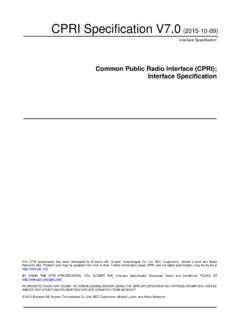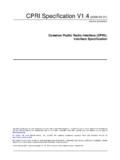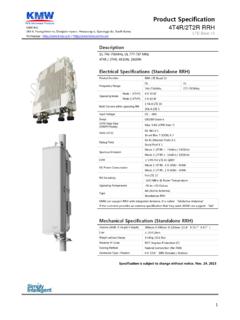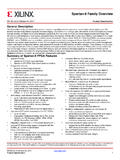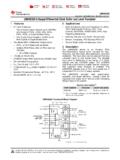Transcription of CPRI Specification V4 - Common Public Radio Interface
1 CPRI Specification (2010-09-29) Interface SpecificationCommon Public Radio Interface (CPRI); Interface Specification The CPRI Specification has been developed by Ericsson AB, Huawei Technologies Co. Ltd, NEC Corporation, Alcatel Lucent and Nokia Siemens Networks GmbH & Co. KG (the Parties ) and may be updated from time to time. Further information about CPRI, and the latest Specification ,may be found at BY USING THE CPRI Specification , YOU ACCEPT THE Interface Specification Download Terms and Conditions FOUND IN ORDER TO AVOID ANY DOUBT, BY DOWNLOADING AND/OR USING THE CPRI Specification NO EXPRESS OR IMPLIED LICENSE AND/OR ANY OTHER RIGHTS WHATSOEVER ARE GRANTED FROM ANYBODY. 2009 Ericsson AB, Huawei Technologies Co. Ltd, NEC Corporation, Alcatel Lucent, and Nokia Siemens Networks GmbH & Co.
2 KG.. CPRI CPRI Specification (2010-09-29)2 Table of Contents 1. Introduction ..4 2. System Description ..6 Definitions/Nomenclature ..6 System Reference Functional Radio Functionality ..13 CPRI Control Functionality ..14 3. Interface Supported Radio Standards ..15 Operating Topology/Switching/Multiplexing ..15 Bandwidth/Capacity/Scalability ..17 Capacity in terms of Required U-plane IQ Sample Required C&M-plane Bit Rate ..19 Frequency Synchronization ..19 Frame Timing Information ..20 Link Timing Accuracy ..21 Round Trip Delay Accuracy ..21 Accuracy of TDD Tx-Rx switching point ..22 Delay Calibration ..22 Round Trip Cable Delay per Link ..22 Round Trip Delay of a Multi-hop Link Maintenance.
3 23 Quality of Service ..24 Maximum Delay ..24 Bit Error Ratio U-plane ..24 Bit Error Ratio C&M-plane ..24 Start-up Clock Start-up Time Requirement ..25 Plug and Play Requirement ..25 4. Interface Specification ..27 Protocol Overview ..27 Physical Layer (Layer 1) Specification ..28 Line Bit Rate ..28 Physical Layer Modes ..28 Electrical Interface ..30 Optical Interface ..30 Line Coding ..30 Bit Error Frame Synchronisation and Timing ..55 Link Delay Accuracy and Cable Delay Calibration ..56 Link Maintenance of Physical Layer ..59 Data Link Layer (Layer 2) Specification for Slow C&M Channel ..64 Layer 2 Framing ..64 Media Access Control/Data Mapping ..64 Flow Control ..65 Control Data Protection/ Retransmission Mechanism.
4 65 Data Link Layer (Layer 2) Specification for Fast C&M Channel ..65 CPRI CPRI Specification (2010-09-29)3 Layer 2 Framing ..65 Media Access Control/Data Mapping ..66 Flow Control ..68 Control Data Protection/ Retransmission Mechanism ..68 Start-up General ..68 Layer 1 Start-up State Description ..70 Transition Description ..74 5. Interoperability ..77 Forward and Backward Compatibility ..77 Fixing Minimum Control Information Position in CPRI Frame Structure ..77 Reserved Bandwidth within Version Specification Release Version mapping into CPRI Frame ..77 Compliance ..78 6. Annex ..79 Delay Calibration Example (Informative)..79 Electrical Physical Layer Specification (Informative) ..82 Overlapping Rate and Technologies.
5 82 Signal Eye Diagram and Jitter ..83 Reference Test Points ..84 Cable and Impedance ..84 AC Coupling ..84 TX Receiver Performances ..90 Measurement Procedure ..93 Networking (Informative) ..94 Concepts ..94 Reception and Transmission of SAPCM by the Reception and Transmission of SAPIQ by the Reception and Distribution of SAPS by the RE ..95 Reception and Transmission of CPRI Layer 1 Signalling by the Bit Rate More than one REC in a Radio base The REC as a Networking Element ..96 E-UTRA sampling rates (Informative) ..96 Scrambling (Normative) ..96 Receiver ..100 7. List of 8. References ..104 9. History ..105 CPRI CPRI Specification (2010-09-29)4 1. Introduction The Common Public Radio Interface (CPRI) is an industry cooperation aimed at defining a publicly available Specification for the key internal Interface of Radio base stations between the Radio Equipment Control (REC) and the Radio Equipment (RE).
6 The parties cooperating to define the Specification are Ericsson AB, Huawei Technologies Co. Ltd, NEC Corporation, Alcatel Lucent and Nokia Siemens Networks GmbH & Co. KG. Motivation for CPRI: The CPRI Specification enables flexible and efficient product differentiation for Radio base stations and independent technology evolution for Radio Equipment (RE) and Radio Equipment Control (REC). Scope of Specification : The necessary items for transport, connectivity and control are included in the Specification . This includes User Plane data, Control and Management Plane transport mechanisms, and means for synchronization. A focus has been put on hardware dependent layers (layer 1 and layer 2). This ensures independent technology evolution (on both sides of the Interface ), with a limited need for hardware adaptation.
7 In addition, product differentiation in terms of functionality, management, and characteristics is not limited. With a clear focus on layer 1 and layer 2 the scope of the CPRI Specification is restricted to the link Interface only, which is basically a point to point Interface . Such a link shall have all the features necessary to enable a simple and robust usage of any given REC/RE network topology, including a direct interconnection of multi-port REs. Redundancy mechanisms are not described in the CPRI Specification , however all the necessary features to support redundancy, especially in system architectures providing redundant physical interconnections ( rings) are defined. CPRI CPRI Specification (2010-09-29)5 The Specification has the following scope (with reference to Figure 1): 1.
8 A digitized and serial internal Radio base station Interface that establishes a connection between Radio Equipment Control (REC) and Radio Equipment (RE) enabling single-hop and multi-hop topologies is 2. Three different information flows (User Plane data, Control and Management Plane data, and Synchronization Plane data) are multiplexed over the Interface . 3. The Specification covers layers 1 and 2. 3a. The physical layer (layer 1) supports both an electrical Interface ( , what is used in traditional Radio base stations), and an optical Interface ( for Radio base stations with remote Radio equipment). 3b. Layer 2 supports flexibility and scalability. Figure 1: System and Interface Definition 1 The CPRI Specification may be used for any internal Radio base station Interface that carries the information flows mentioned in the scope of point 2.
9 Radio Equipment (RE) Radio Equipment Control (REC)Layer 1 Layer 2 Control & Mgmt. UserSync. Air InterfaceNetwork Interface Digitized Radio Base StationInternalInterfaceSpecificationLay er 1 Layer 2 Control & Sync. CPRI CPRI Specification (2010-09-29)6 2. System Description This chapter describes the CPRI related parts of the basic Radio base station system architecture and defines the mapping of the functions onto the different subsystems. Furthermore, the reference configurations and the basic nomenclature used in the following chapters are defined. The following description is based on the UMTS (Universal Mobile Telecommunication System), WiMAX Forum Mobile System Profile [11] based on IEEE Std [13] and Evolved UMTS Terrestrial Radio Access (E-UTRA).
10 However, the Interface may also be used for other Radio standards. Definitions/Nomenclature This section provides the basic nomenclature that is used in the following chapters. Subsystems: The Radio base station system is composed of two basic subsystems, the Radio equipment control and the Radio equipment (see Figure 1). The Radio equipment control and the Radio equipment are described in the following chapter. Node: The subsystems REC and RE are also called nodes, when either an REC or an RE is meant. The Radio Base Station system shall contain at least two nodes, at least one of each type; REC and RE. Protocol layers: This Specification defines the protocols for the physical layer (layer 1) and the data link layer (layer 2).




